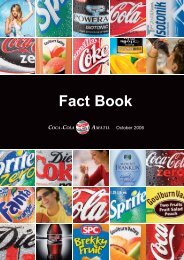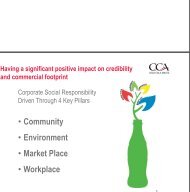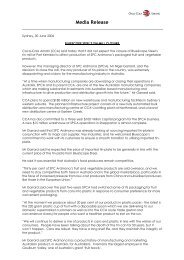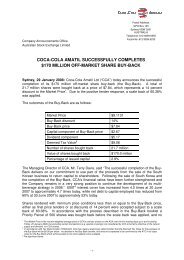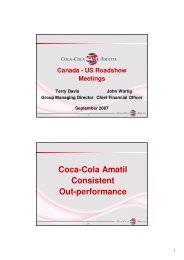2006 Sustainability Report - Coca-Cola Amatil
2006 Sustainability Report - Coca-Cola Amatil
2006 Sustainability Report - Coca-Cola Amatil
Create successful ePaper yourself
Turn your PDF publications into a flip-book with our unique Google optimized e-Paper software.
Environment continued<br />
SAVING ENERGY<br />
CCA’s National Contact Centre in<br />
St Leonards, Sydney fitted a “Light Eco”<br />
device to their lighting board which<br />
controls all lighting in the centre. This<br />
device saved more than 30% of the<br />
power used by the fluorescent lights<br />
with minimal effect on the lighting levels.<br />
Not only did this reduce CO 2 emissions<br />
by an estimated 102 tonnes per year, it<br />
also resulted in savings of around<br />
$10,000 a year in energy bills.<br />
The company which provided the<br />
Light Eco device coordinated the<br />
planting of 102 trees on behalf of<br />
CCA to signify the CO 2 emission saving.<br />
LESS PACKAGING<br />
Since introducing lightweighting of<br />
PET bottles for carbonated soft drink<br />
products in 2003, CCA Australia has<br />
saved 18,000 tonnes of PET.<br />
A number of other packaging initiatives<br />
have commenced reducing the amount<br />
of corrugated board, stretch and shrink<br />
film required to package our products.<br />
CCA developed trials to test a new<br />
innovation in packaging, the 1.25 litre<br />
“cray”, or cardboard tray, which<br />
reduced cardboard by 53% and glue<br />
by 65%, and improved functionality.<br />
Packaging<br />
CCA uses PET, glass, aluminium<br />
and cardboard as its major packaging<br />
materials. All contain recycled<br />
material. In 1994 CCA was the first<br />
company in the world to package a<br />
food grade product using recycled<br />
content in PET and since that time<br />
we have continued to make significant<br />
progress in reducing the amount of<br />
material used in our packaging to<br />
minimise environmental impacts,<br />
while maintaining the integrity of<br />
our product.<br />
In <strong>2006</strong> we reduced our product<br />
to packaging ratio by weight from<br />
15:1 in 2005, to 14.8:1, thanks to<br />
lightweighting and packaging<br />
reduction initiatives.<br />
In recognition for our initiatives<br />
CCA was awarded Highly<br />
Commended in the Beverage<br />
Packaging Action category of the<br />
<strong>2006</strong> Packaging Evolution Awards.<br />
National Packaging<br />
Covenant<br />
CCA is a founding member of the<br />
Australian National Packaging<br />
Covenant (NPC), a joint initiative set<br />
up in 1999 between government and<br />
industry to manage the environmental<br />
impacts of consumer packaging.<br />
In our <strong>2006</strong> NPC Action Plan CCA<br />
focused on four areas (for details see<br />
www.ccamatil.com):<br />
• to significantly improve the integrity<br />
of our data through improved data<br />
collection.<br />
• implement the Environmental Code<br />
of Practice for Packaging (ECoPP).<br />
• drive the formation of the Australian<br />
Food and Grocery Council’s<br />
Packaging Stewardship Forum.<br />
• raise the profile of away from home<br />
recycling, with our Luna Park public<br />
place recycling trial.<br />
CCA is also a signatory to the<br />
Packaging Accord in New Zealand,<br />
where we have joined forces with<br />
industry, government, waste<br />
management and other nongovernment<br />
organisations as active<br />
members of the Accord and the<br />
Government-led Litter Alliance.<br />
The New Zealand business has also<br />
established a beverage industry action<br />
group (EBAG) to address and achieve<br />
targets set under the Packaging Accord.<br />
Public Place Recycling<br />
CCA wants to see more of our<br />
packaging recycled and will continue<br />
to look at all proposed environmental<br />
initiatives. We believe that any<br />
solution to beverage waste must have<br />
an overall environmental benefit.<br />
At present, Australia’s successful kerbside<br />
collection system contributes around<br />
40% of total packaging recycling.<br />
Australians recycle around 70% of the<br />
beverage containers they consume at<br />
home – they do so because there is a<br />
convenient and low-cost process for<br />
them to use. We need to have a<br />
convenient process for them when<br />
they are away from home – the right<br />
bins in the right places with the right<br />
recycling messages.<br />
CCA’s “Refresh, Recycle, Renew”<br />
campaign launched in Australia<br />
in 2004, is aimed at encouraging<br />
the implementation of away from<br />
home recycling.<br />
16



